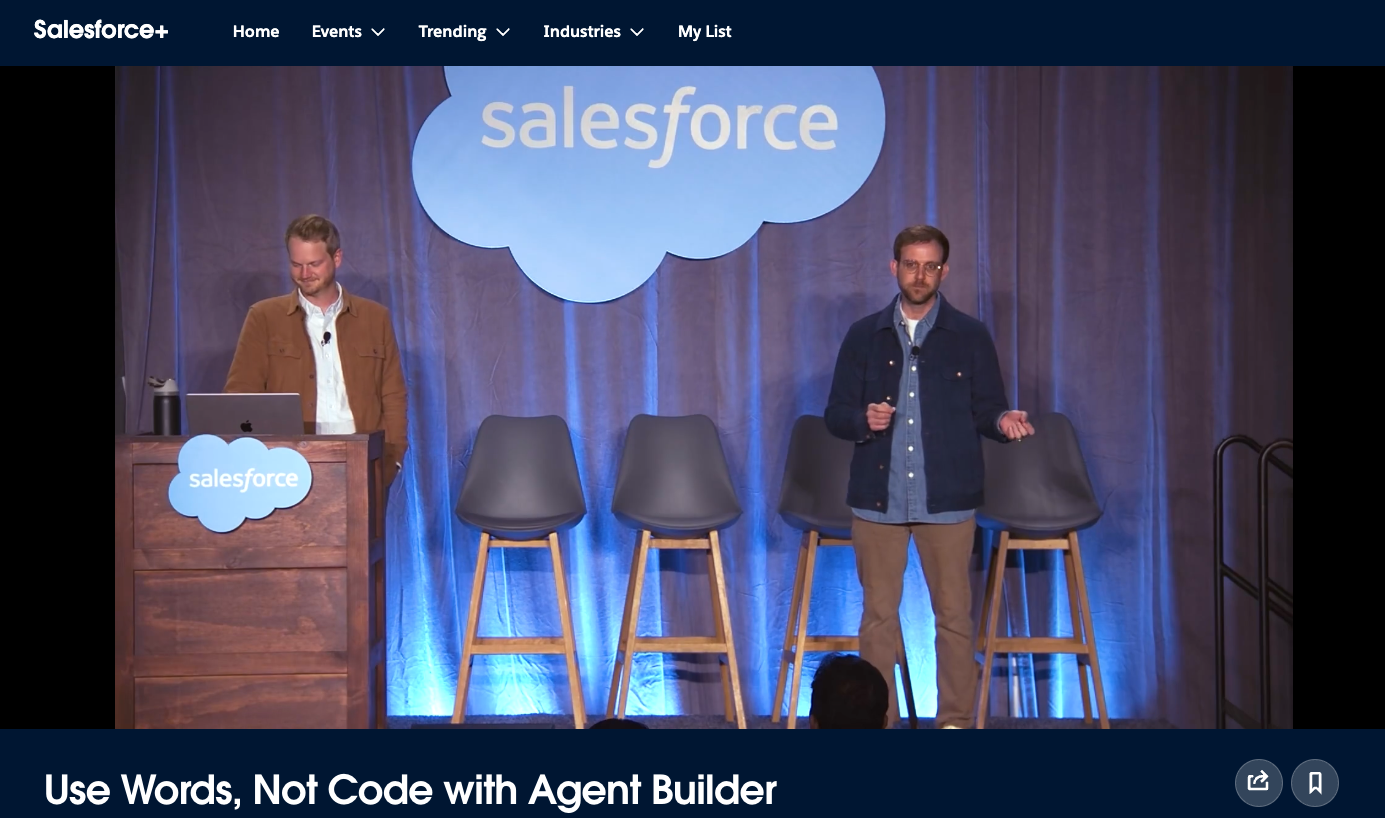With three days of programming and more than 1,000 sessions, there’s always so much to learn at Dreamforce. If you’re able to attend in person – or even if you watch highlights from home – it’s hard to absorb it all.
We thought a curated list of the sessions we developed from the Experience org (user experience, research and insights, UX engineering, product design) might help. Across our presentations and Camp Design demos and activities, a few themes arose:
- Trust in AI is built through design, not just technology.
- Context engineering connects human intent and AI performance.
- The future of work is conversational and collaborative.
Check out our linked resources that follow or bookmark this blog for reference later.
Popular sessions
Session: 6 UX Design Tips to Make AI Trustworthy and Easier to Use
Learnings: This session offered practical ways to make AI experiences feel more natural and human. Real examples from Slack, Agentforce Sales, and Agentforce Service illustrated how thoughtful UX keeps people informed and in control, instead of overwhelmed. By emphasizing transparency, user choice, and clear communication, the session showed how simplifying setup can help everyone engage with AI more confidently and effectively.
Take a deeper dive: companion blog and deck
Session: Build Reliable, On-Brand Experiences with SLDS 2
Learnings: This session spotlighted how SLDS 2 helps teams deliver consistent, accessible, and future-ready user experiences. Through examples of global styling hooks and Figma kit integrations, attendees learned how design and development can stay in sync while still allowing for customization. The discussion also covered how tools like SLDS Linter simplify modernization, reducing technical debt and paving the way for features such as dark mode (beta).
Take a deeper dive: deck

Session: Unpack How Agentforce Voice Shapes Future Agent Experiences
Learnings: Attendees were introduced to Agentforce Voice, a major step forward in Salesforce’s vision for natural, conversational customer engagement. The session demonstrated how voice agents can be tuned to reflect brand personality, handle context-rich interactions, and seamlessly connect to digital channels. More than a product update, this was a glimpse into a future where voice interactions are intuitive, efficient, and deeply human-centered.
Take a deeper dive: deck
Session: Create Smarter Experiences with Context Engineering
Learnings: This session explored how context engineering can make AI-driven development smarter, more accurate, and easier to maintain. Attendees learned how structuring prompts, documentation, and design system details helps AI generate reliable SLDS 2 components and production-quality code. The key takeaway was that providing intentional context bridges the AI knowledge gap, reduces errors, and empowers developers to build consistent, accessible, and efficient Salesforce applications.
Take a deeper dive: deck
Speaking of SLDS 2, have you transitioned yet?
Session: Build Trusted AI-Ready Components with SLDS 2
Learnings: Attendees got an inside look at how SLDS 2 supports the creation of components designed for AI-powered workflows. The session highlighted the Cosmos theme, reusable patterns, and a modular CSS framework that reduces complexity and builds trust through clarity and consistency. With tighter integration between Figma and SLDS, teams can design and deploy AI-ready components – like those powering Agentforce – with speed, precision, and confidence.
Take a deeper dive: deck
Session: Peek Under the Hood of Dark Mode and Transition to SLDS 2
Learnings: This session gave designers and developers an inside look at dark mode (beta) for Salesforce, built on the new SLDS 2 framework. Attendees discovered how styling hooks, the Cosmos theme, and the SLDS Linter simplify customization while maintaining accessibility and brand consistency. Beyond aesthetics, dark mode represents a broader shift toward scalable, adaptable design systems that improve usability and reduce strain for users across every environment.
Take a deeper dive: deck
Embrace Slack
Session: How Slack Builds Agents That Aren’t a Pain to Use
Learnings: This session revealed how Slack’s design principles shape AI features that truly serve people, not just processes. Attendees saw how ideas like “Don’t Make Me Think” and “Be a Great Host” guide the creation of intuitive agentic teammates, from smarter search to conversational shortcuts that simplify everyday work. The discussion underscored how prototyping, iteration, and empathy-driven design help Slack deliver AI that enhances collaboration instead of complicating it.
Take a deeper dive: deck
Session: How to Talk to Your AI Agent to Make It a Better Teammate
Learnings: In this session, attendees explored how conversational design transforms AI from a tool into a teammate. By focusing on intent, ambient awareness, and amplification, speakers showed how AI agents can anticipate needs, automate complex processes, and lighten cognitive load. Real-world examples from Slack illustrated how measuring AI’s impact on time savings and focus can help teams shift from repetitive work to more creative, strategic contributions.
Take a deeper dive: deck
On Salesforce+: Agent Builder and conversation design
Session: Use Words, Not Code with Agent Builder
Learnings: This session showcased how the new Agent Builder empowers anyone to design AI agents simply by describing what they need, all in plain language. Demonstrations covered deterministic controls, in-line AI assistance, and powerful debugging tools that provide both transparency and precision. Attendees saw how this balance of low-code simplicity and pro-code flexibility helps teams move faster while keeping collaboration tight between business users and developers.
Take a deeper dive: deck

Session: Why Prompting Alone Won’t Stop AI Agents from Going Rogue
Learnings: Trust doesn’t come from good prompts alone – and this session made that clear. Attendees learned how conversation design, memory, and ethical guardrails form the foundation for safe, consistent AI behavior. By tracking metrics like task completion, containment, and user trust, teams can ensure agents act with clarity, reliability, and respect. The result: AI that feels not just capable, but trustworthy and human-aligned.
Take a deeper dive: deck



























